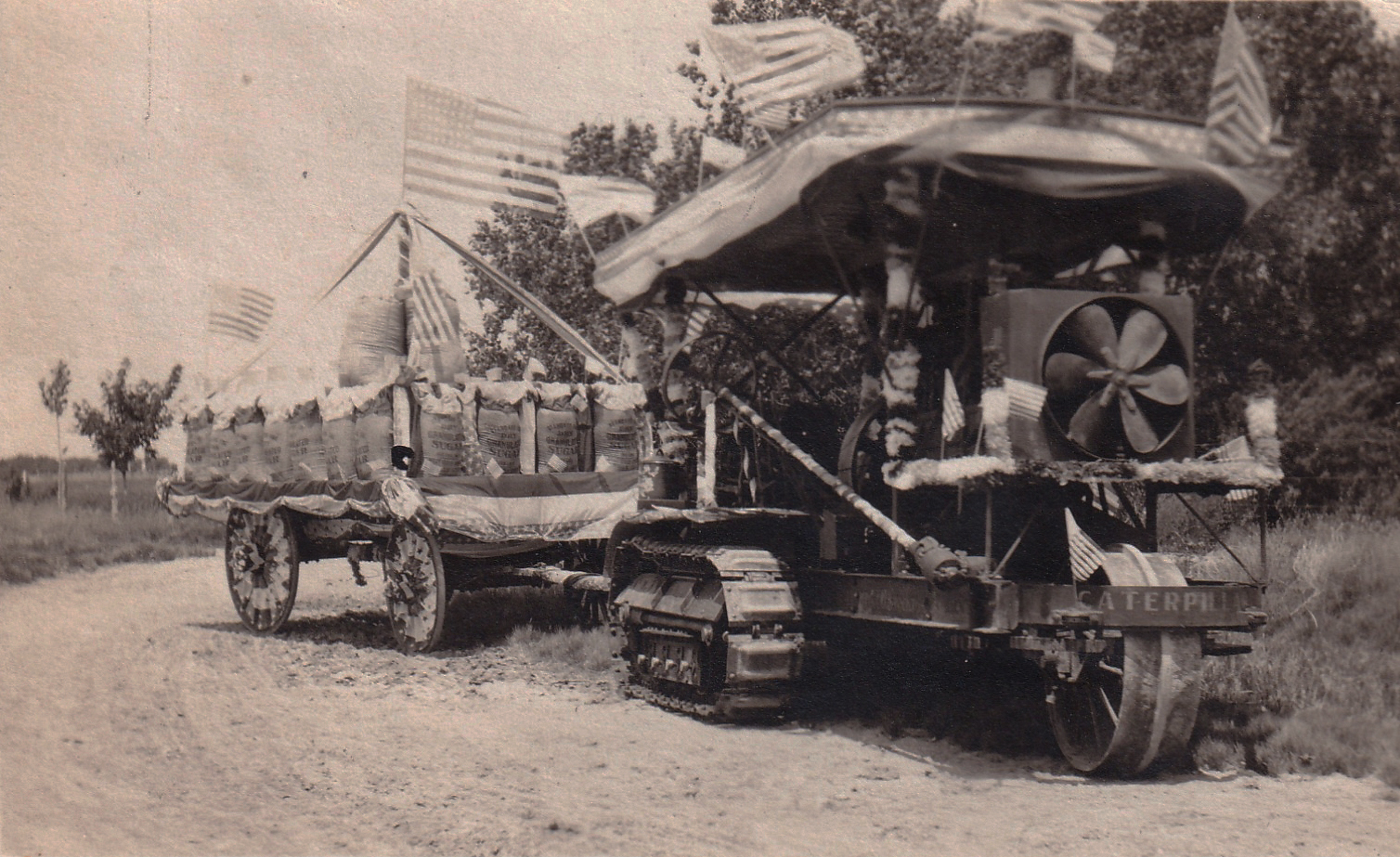This windblown flag-bedecked Holt Caterpillar with a trailer holding sacks labeled “granulated sugar” may be an entrant in a Fourth of July parade held in Holly, Colorado. Beet sugar was integral to the towns of both Holly and Swink, which are located in southeastern Colorado on the Arkansas River about 90 miles from each other.
Kenneth Schley founded the Holly Sugar company in Holly in 1905. He named it Holly, not after the town, but because holly berries were traditional symbols of friendship and good cheer. (The town of Holly was named for early settler and cattleman Hiram S. Holly.) Schley soon expanded the company by building a factory in Swink. The company’s next expansion was in 1911, when Holly Sugar bought into sugar production in Orange County, California, where it enlarged a factory in Santa Ana and built a new factory at Huntington Beach. In 1915, the operations of the Holly and Swink factories were consolidated at Swink, and the Holly plant was closed. By 1931, Holly Sugar had acquired or built eleven more factories in Montana, Texas and Wyoming and would become the largest sugar beet processor in the United States. In 1955, with sugar beet production on the decline in the Arkansas River Valley, the Swink plant ceased sugar production, and by 1982 both of the Orange County factories had been closed.
Credit for the invention of the Caterpillar tractor, equipped with self-laying tracks instead of wheels, is given to Benjamin Holt. One of eleven children, Holt was born in Concord, New Hampshire, in 1849, and at age 20 began working in his father’s sawmill, which processed hardwoods for use in wagon and coach construction. By age 23, Benjamin’s father had given him an interest in the business, and he was put in charge of shipping lumber to the west coast.
Benjamin’s brother, Charles, went to San Francisco, where he would establish C. H. Holt and Company to produce wooden wagon wheels and, later, steel streetcar wheels. His brothers William and Ames would later join him in the manufacture of wagon axles, wheels and frames. The brothers would discover, to their dismay, that the wooden wheels they made in San Francisco’s damp climate would fall apart in more arid climes, such as that found in California’s San Joaquin Valley. So, in 1883 they moved to Stockton, California, where they would form the Stockton Wheel Company, and where they would also be joined by their brother Benjamin. (The Stockton Wheel Company would eventually be sold, but is still in business in Stockton under the name Stockton Wheel Service, Inc.)
Benjamin, a born inventor, would take over the invention and production end of the business. He would invent a horse-drawn “Link-Belt Combined Harvester,” which used chains instead of gears to transmit power from the ground wheels to the working mechanism, which reduced down time due to gear breakage. In 1890 Benjamin built his first experimental steam-powered traction engine, or tractor. (The term “traction” is based on the Latin “tractus,” which means ‘drawn’, since the primary purpose of any traction engine is to draw a load behind it.) It was a big’n. With a full 675-gallon water tank, it weighed in at 12 tons. To see an example of the large size of Holt’s early tractors, see the first image at https://www.holtcat.com/about_us/a_heritage_of_innovation . In 1892, the company incorporated as the Holt Manufacturing Company, with Benjamin Holt as president.
The Holts encountered problems with their heavy steam tractors getting bogged down in the soft peaty soils of the San Joaquin River delta farmland outside of Stockton. They tried “floating” their tractors on the soil by attaching huge wooden rim extensions, some as wide as 18 feet, on the drive wheels, but with mixed results. Some still sank into the muck, and in some cases it would take days to extricate them. The continuous wide-treaded track proved to be the solution.
Charles Clements, a photographer who observed a Holt tractor in action on its continuous track, said “it crawls, just like a caterpillar.” Benjamin Holt agreed, and “Caterpillar” would become the registered trademark for the Holt crawling machines. The Holt corporation sold its first steam crawler tractor in 1906 for $5,500 to a land company in Lockport, Louisiana, The company had unintentionally managed to bury a Holt steam wheeled tractor in attempting to plow some Mississippi delta land. The Holt steam crawler they purchased would serve them well for many years on the marshy Louisiana ground. Holt ads would proclaim that the Caterpillar tractor “has no wheels to slip,” nor will it “pack your land.”
In 1908, the Holt company began manufacturing gasoline-powered crawler tractors and in 1916 decided to move the engine toward the back, so that its weight would sit above the tracks. Thus, the crawler would no longer need the front “tiller wheel” which you see on the tractor in the photo.
In 1925, the Holt Manufacturing Company would merge with a long-time competitor, the Best Tractor Company, known for its harvesters, tractors and other farm equipment. The resulting company would be named the Caterpillar Tractor Company. Today it is known as Caterpillar, Inc., and is located in Deerfield, Illinois.
REFERENCES
- Ad, Denver Weekly Post dated June 7, 1913, Colorado Historic Newspapers Collection at https://www.coloradohistoricnewspapers.org/?a=d&d=DWP19130607-01.2.93.3&srpos=8&e=——-en-20–1–img-txIN%7ctxCO%7ctxTA-holt+caterpillar+tractor——-0——
- “Benjamin Holt,” Wikipedia at https://en.wikipedia.org/wiki/Benjamin_Holt
- “The Best Holt and Best Story You’ve Never Heard,” Caterpillar at https://www.caterpillar.com/en/news/caterpillarNews/history/caterpillarhistorycomestolife.html
- “Caterpillar History,” Antique Caterpillar Machinery Owners Club (ACMOC) at https://www.acmoc.org/about/cat-history
- “Caterpillar Inc.” Wikipedia at https://en.wikipedia.org/wiki/Caterpillar_Inc.
- Distance between Cities at https://www.distance-cities.com/distance-holly-co-to-swink-co
- “The Farm Tractor,” (page 103) by Bob Feller and Ralph W. Sanders, Google Books at https://www.google.com/books/edition/The_Farm_Tractor/Qu33Rct3bukC?hl=en&gbpv=1&dq=how+is+the+soil+of+joaquin+river+delta+for+tractors&pg=PA103&printsec=frontcover
- Garden City Telegram dated July 24, 1959, at https://www.newspapers.com/browse/us/colorado/
- “Holly, Colorado” Wikipedia at https://en.wikipedia.org/wiki/Holly,_Colorado
- “Holly Sugar,” by Dr. John Harner, Colorado Springs Pioneers Museum at https://www.cspm.org/cos-150-story/holly-sugar/
- Nelson Family Tree (www.ancestry.com)
- “Our History,” Stockton Wheel Service Inc.at http://www.stocktonwheel.com/history.html
- Photo of 1910 Holt Caterpillar, flickr at https://www.flickr.com/photos/d70w7/7963646352/
- “Traction engine,” Wikipedia at https://en.wikipedia.org/wiki/Traction_engine

